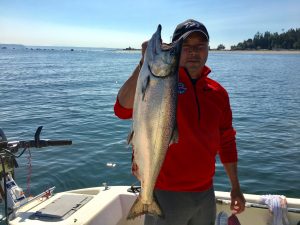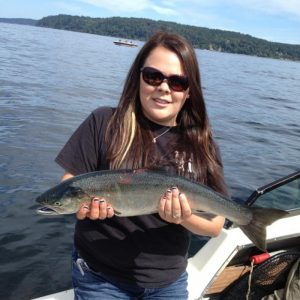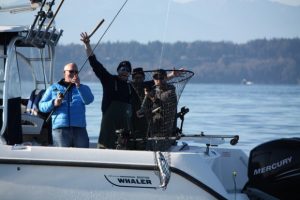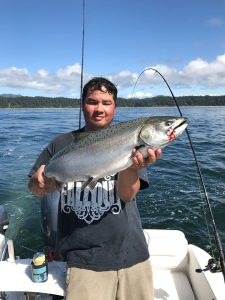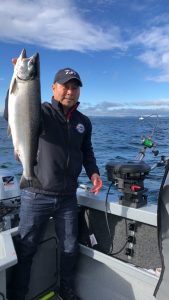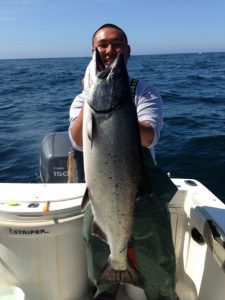State fisheries experts offer cautious optimism for 2019 salmon runs and for most part 2018 was better than expected Leave a reply
We’re still a couple weeks away from getting our first look at what some early salmon forecasts have in store for our sport fisheries in 2019 but here’s early insight on what to expect as well as pink salmon that return during odd-numbered years.
“We are just starting to get the spawning surveys and forecasts compiled,” said Marisa Litz, the WDFW pink and chum salmon biologist. “What we know for pinks is that a lot of fry can produce a lot of fish. Pinks are known to produce a lot of fry even coming off low returns. We won’t know for sure what 2019 holds but if we get that type of production we may see somewhat of an uptick in pinks.”
The pinks seem to be very prolific fish, and the run doubled from 1997 to 1999 and likewise in 1991 when 500,000 pinks returned and then soared to 1-million by 1993 although it is not a guarantee nor a consistent situation.
“It is something to be cautiously optimistic about,” Litz said.
WDFW and tribal co-managers are in the process of completing drafts for all salmon returns and the pink draft estimate for 2017 wasn’t very rosy.
“The pink runs are very boom or bust and we can see some pretty dramatic changes,” Litz said. “The total pink return was 480,858 pinks in 2017 (down from preseason forecast that year of 1,150,522) and to give you some context this is the lowest run size since we’ve seen since 1997.”
In terms of a run-size and prior to 1997 you’d have to go all the way back to 1975 to see a lower run than that. Litz pointed out the 2017 pink return puts it in the top three lowest runs in the past 40 years.
For the past 15 years pink returns have steadily increased with more than a 1-million returning in 2013, which was a record setting year.
“We had a lot of flooding and drought conditions in 2015,” Litz said. “That summer rivers were extremely low, and the spawning channels were very narrow when the pinks arrived. Then we had big floods and scouring of spawning beds and that wiped out a lot fish.”
The reductions from 2015 to 2017 was drastic especially in the freshwater production environment but the marine production was also hampered with a blow to the arm by the “Blob” – a mass of warm water that wreaked havoc on the Pacific Ocean ecosystem.
Here is a look at how some Puget Sound pinks returns fared in 2017:
The Dungeness River had a pink return of 356,000 in 2015 and was 20,000 in 2017; Nooksack was 335,000 to 35,000 (96,218 was preseason forecast); Skagit was 411,000 to 86,000 (85,600); Hood Canal was 646,000 to 39,000 (229,440); Puyallup was 800,000 to 100,000 (382,391); and Nisqually was 200,000 to 9,000 (21,463).
“The Green pink return was just getting started and new to this river system and we had close to 100,000 in 2013,” Litz said. “It appears the run is there to stay we had about 50 percent less come back in 2017 (118,689) to what we saw in 2015.”
The Fraser River pink return was estimated at more than 8-million in 2017 and run-size ended up being 3,616,000 with an escapement goal of 6-million. That actual return was the second lowest since 1965.
A look back at 2018 salmon runs
There was a lot of good news that came out of some salmon returns in 2018 and the bright spot was Puget Sound hatchery chinook.
“We’re really feeling good about chinook last year especially after having to deal with mid-Hood Canal impacts, coming down on the exploitation rates and cutting catch quotas and time on the water,” said Mark Baltzell, the WDFW salmon resource manager.
Hatchery chinook abundances and Puget Sound chinook forecasts were at or just above preseason forecasts.
“Catches were through-the-roof good in central Puget Sound, and we blew through the hatchery chinook catch quotas in Areas 9 and 10,” Baltzell said. “My fears in going forward in time and by increasing hatchery production for killer whales is that we may have more seasons like 2018 where we had good fishing, but it was short-lived because of wild chinook impacts in Puget Sound.”
WDFW doesn’t conduct catch estimates for places like southern Puget Sound (Area 13), but anglers managed to find very good success for hatchery kings. Even in the San Juan Islands (Area 7) – while it was a down year for chinook and wasn’t as good as it had been – anglers did manage to find good fishing.
Resort owners at Sekiu in western Strait of Juan de Fuca noted a change in the summer chinook migration pattern the past couple of years. What used to be a near shore fishery at places like the Caves, Slip Point and Mussolini Rock has now become more of a deep-water fishery for kings with anglers having better success in 200 feet or deeper water.
As for Puget Sound coho, Baltzell says his gut feeling was WDFW was probably right on par with preseason forecasts this year.
“Some coho runs came in higher than forecasted,” Baltzell said. “The Skagit being one of them and I’m a bit nervous of what we’ll see for the Snohomish system where we had a closure to meet that extra escapement goal.”
“In general places like Area 10 (central Puget Sound) from what we saw and heard it was good all summer from when it opened in June people were catching coho and it didn’t stop through the fall,” Baltzell said. “It looked like we had a good abundance of resident coho and then when the migratory coho came back it remained good.”
One noticeable difference this fall was northern Puget Sound (Area 9) which was a hatchery coho only fishery and effort was down markedly from past years. Early estimates indicate about 10,000 or less anglers fished Area 9 compared to past seasons when it was around 25,000.
Ocean coho fisheries good but not so for kings
Anglers who ventured off the coast managed to find good coho fishing this past summer and the king fishing never really took off.
“We had a pretty darn good coho fishery coast-wide and had a couple places close, which reached their coho quota early and while that is never good news what it means is that we caught fish,” said Wendy Beeghly, the WDFW coastal salmon manager. “Chinook fishing was slow everywhere last year. It makes sense since chinook returns weren’t very good in the Columbia River.”
Beeghly noted the coho seen in sampling were healthy, bigger and fatter so that was encouraging.
“While we can’t provide anything definitive just yet from what we saw with coho last season was good news compared to prior years and we all hope that what’s lies ahead will be good,” Beeghly said.
Federal fisheries managers are also reporting that environmental conditions in the ocean are improving, salmon productivity has made a turn for the better and the food chain is on the mend.
“The coho response to those factors should be a lot quicker than chinook which take some time and are slower to recover,” said Ryan Lothrop, a WDFW salmon specialist for the Columbia River region.
WDFW will present their salmon forecasts during a public meeting at the end of February in Olympia. The Pacific Fishery Management Council will approve final salmon seasons on April 9-16 in Rohnert Park, CA.



